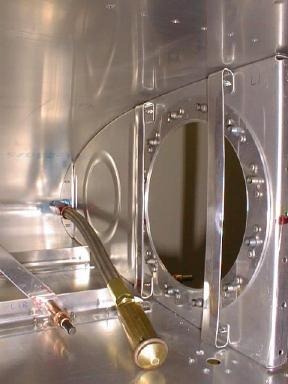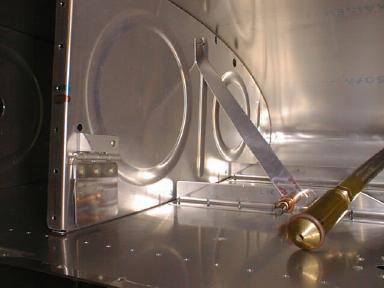Van details a series of modifications that can be done to allow a fuel tank to feed fuel even if the aircraft is in inverted flight. I decided to do these mods to the left tank.
 Here you see inside the inboard end of the left tank, looking forward. The back wall of the tank has been removed.
Here you see inside the inboard end of the left tank, looking forward. The back wall of the tank has been removed.
You can see the large hole where the inspection cover is in the inboard rib. The bolts that fasten the inspection cover on screw into the plate nuts that you see riveted to the reinforcing ring.
You can also see the flop tube, a flexible tube with a weighted end through which the fuel feeds. No matter which way the aircraft is pointed, the fuel and the flop tube end up in the same corner of the tank (except if you are going straight down - it is not flexible enough to go to the front of the tank).
The two vertical strips by the inspection cover are there to keep the flop tube from getting hung up on the anchor nuts.
The tank ribs have two large holes in them to allow the fuel to flow from bay to bay. If you do the inverted fuel mod, you have to deal with these holes. In upright flight, the fuel will stay in the inboard bay (where the fuel pick up is) due to the dihedral of the wings. But, in inverted flight, the fuel will want to go to the outboard end of the tank, and the fuel pick up will be sucking air.
 The rib which forms the outboard end of the first bay in the tank is modified to address this problem. One of the holes is left out of this rib. The other hole is covered with a little flapper valve made from a piece of aluminum and a piece of piano hinge. The valve will swing out of the way to allow fuel into the inboard bay, but it will close off the hole to slow the exit of fuel from the bay in inverted flight. The fuel will leak through the flapper valve, and also through the smaller holes, so you can't stay in inverted flight too long.
The rib which forms the outboard end of the first bay in the tank is modified to address this problem. One of the holes is left out of this rib. The other hole is covered with a little flapper valve made from a piece of aluminum and a piece of piano hinge. The valve will swing out of the way to allow fuel into the inboard bay, but it will close off the hole to slow the exit of fuel from the bay in inverted flight. The fuel will leak through the flapper valve, and also through the smaller holes, so you can't stay in inverted flight too long.
You can also see a strip of aluminum that will be riveted between the rib and the stiffener on the bottom of the tank. This strip keeps the flop tube from getting into the corner between the stiffener and the rib and getting hung up.
The fuel sender normally goes in the inboard bay, but it must be moved to the second bay, so the flop tube doesn't get hung up on it. The sender must be mounted on the rear baffle, whereas it is mounted on the inboard rib in the basic installation. This means that the bending diagram that Van supplies for the fuel sender wire doesn't work. The attached tracing shows how I bent my fuel sender wire.